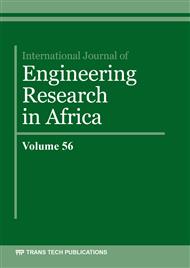p.34
p.51
p.64
p.77
p.95
p.111
p.123
p.136
p.145
Experimental Investigation on the Microstructural Properties of Black Cotton Soil Stabilized with Cinder (Scoria) Fines and Class-C Fly Ash
Abstract:
Black cotton soil is one of the significant problematic soil for any civil or geotechnical engineering application in the whole world. In the past several decades, different experimental studies have been carried out on the stabilization of expansive soil and different types of stabilizers like lime, Portland cement, cement fly ash, and lime fly ash were used and applied in highway and others construction. However, those traditional stabilizers are not environmentally friendly thus further scientific study is needed to minimize the percentage of carbon-based stabilizers. The fact that Ethiopia encountered major engineering problems due to these problematic soils many researchers have been conducted a vital study using traditional stabilizers for several years however there is no significant study on the microstructural properties of stabilized black cotton soil. In this study, a scoria fines and class c fly ash are used at different blended groups, for each group, the stabilizer content ranges from 10 to 30%. The liquid limit and plasticity index of the soil has been decreased with the increasing content of class c fly ash (FA) and cinder fines (CF). Especially after the soil treated with 25% of class c fly ash and 25% of cinder fines, the liquid limit has decreased by 51.61% and, the plasticity index by 78.61%, linear shrinkage by 66.58%, and the free swell index decreased by 78.9%. The CBR and UCS value has increased by 86.2% and 83.9%, respectively, and CBR swell reduced by 61.2% with increasing stabilizer content. The microstructural properties of Raw black cotton soil and samples that are selected based on strength and index properties (BCS+FA3, BCS+CF3, BCS+CF+FA3) were observed by Scanning electron microscopy (SEM) imagining device, and the result clearly shows the alteration in fabric and morphology of the sample. After treatment with class c fly ash and cinder fines, the laminated configuration of black cotton soil has changed to more flocculated and coherent mass. Also, the SEM image proves that cinder fines impart a mechanical bonding that forms well-developed floccules and a more porous nature. These types of particle arrangement and clay aggregation bring the improvement in index and strength properties.
Info:
Periodical:
Pages:
95-110
Citation:
Online since:
October 2021
Authors:
Keywords:
Price:
Сopyright:
© 2021 Trans Tech Publications Ltd. All Rights Reserved
Share:
Citation:


